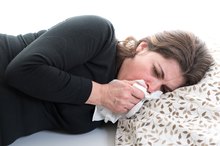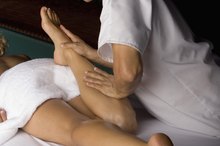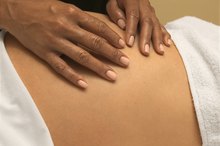Nasal Congestion During Massage & Acupuncture
Massage and acupuncture can provide relief from back and body pain. Routine treatment can reduce your muscle pain, inflammation and joint stiffness. However, many people encounter a surprisingly stubborn phenomenon during the course of a massage or acupuncture session: nasal congestion and nasal drip. Understanding how nasal congestion occurs during treatment and what to do for relief can enhance your experience at the helping hands of a body therapist.
Prone Position
Massage therapy and acupuncture place clients on an ergonomically designed table that can accommodate lying on your belly or back. A massage table has a detachable face cradle and bolsters for the prone position 1. A therapist will position you face down so that the back side is accessible for treatment. Massage and acupuncture in the face down position stimulate two aspects of congestion: histamine release that increases fluids in the nasal area and sinus fluid release from the gravity of being prone.
- Massage therapy and acupuncture place clients on an ergonomically designed table that can accommodate lying on your belly or back.
- Massage and acupuncture in the face down position stimulate two aspects of congestion: histamine release that increases fluids in the nasal area and sinus fluid release from the gravity of being prone.
Take a Deep Breath
How to Get Rid of a Sinus Infection Without Antibiotics
Learn More
There are a couple of options if you get congested or feel a drippy nose while receiving treatment. At the end of the session you can ask for a few minutes of massage devoted solely to the sinus region to reduce pressure on the forehead and behind the eyes. Or you can ask for a drop of eucalyptus oil on a tissue to be placed under the face cradle. With its aromatic camphor scent, eucalyptus can reduce nasal congestion and loosen breathing during massage or acupuncture.
- There are a couple of options if you get congested or feel a drippy nose while receiving treatment.
- At the end of the session you can ask for a few minutes of massage devoted solely to the sinus region to reduce pressure on the forehead and behind the eyes.
Heat and Steam
One of the simplest solutions for congestion is the application of heat and steam to the sinus area. There are different ways to deliver this treatment. You can take a hot shower post-session; this can help relieve sinus pressure and break up congestion. A more targeted approach would be to apply a hot, wet compress (a basic washcloth will do nicely) across your cheek, nose and forehead where sinus pressure can feel the most painful.
- One of the simplest solutions for congestion is the application of heat and steam to the sinus area.
- You can take a hot shower post-session; this can help relieve sinus pressure and break up congestion.
Relief
How to Unclog the Inner Ear or Eustachian Tube
Learn More
A few of these basic techniques can really clear up those passageways either before or after treatment. Another approach is using a neti pot. A neti pot is a simple water apparatus for cleansing sinus passages, and using it prior to a massage can reduce fluid and drainage. If you are suffering from a severe allergy or cold congestion, receiving treatment in the supine position may prove more effective than remaining in the prone position.
- A few of these basic techniques can really clear up those passageways either before or after treatment.
Related Articles
References
- "Introduction to Massage Therapy"; Mary Beth Braun and Stephanie J. Simonson; 2007. Page 369.
- "Aromatherapy: Essential Oils for Vibrant Health and Beauty"; Roberta Wilson; 2002. Page 69.
- MedlinePlus. Sinusitis. Updated May 17, 2018.
- Centers for Disease Control and Prevention. Flu: What to do if you get sick. Updated October 8, 2019.
- American Academy of Allergy, Asthma, & Immunology. Patients self-medicating: persistent rhinitis overuse decongestant nasal sprays. Updated March 31, 2014.
Writer Bio
J. McKee Alderman has contributed to numerous scientific journals on the topics of cancer, diabetes and longevity. Her work has appeared in Gerontology, Hepatology, Experimental Gerontology and The American Journal of Pathology. Alderman holds a B.S. in biology and a M.S. in nutritional biochemistry from the University of North Carolina at Chapel Hill.






